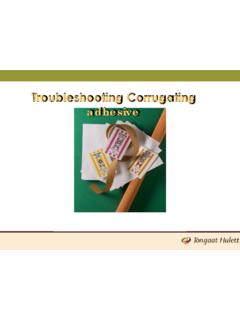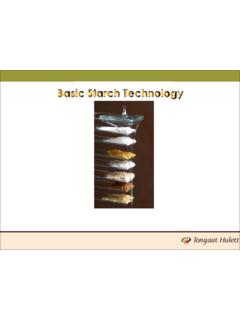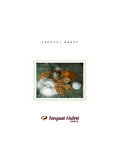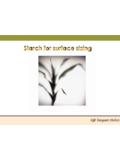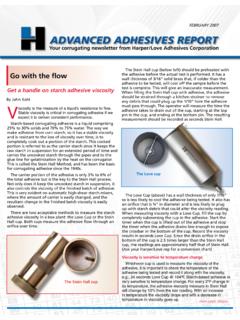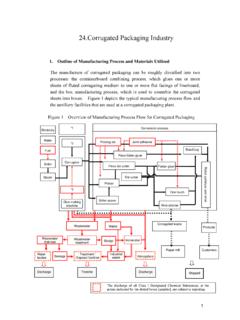Transcription of Starch for Corrugating - Tongaat Hulett Starch
1 Starch for Corrugating Topics Starch adhesive components Adhesive characteristics Adhesive process control (QC). Iodine Staining Issues that can be diagnosed with the iodine staining method Starch Adhesive Components Water Raw OR Secondary Starch ( unmodified ). Caustic - liquid OR Dry Borax OR Boric acid Other - Preservatives - WRA. - Bond Enhancers - Defoamer Water Necessary component in gelatinizing of Starch : - cooking raw Starch - swelling Starch granules Reduces carrier temperature Dilutes carrier to permit pearl Starch addition Controls viscosity Inexpensive VEHICLE FOR ADHESIVE PENETRATION . Raw OR Native Starch Has natural adhesion properties Can be dissolved in water using heat or chemical energy Once dissolved in water and then dehydrated, it Set Back to form a sticky paste and eventually a rigid film of adhesion Possesses a significant AFFINITY for paper Gelatinizes to form the bond between the two sheets of paper Green Bond Formation Caustic Controls the gel temperature Provides the chemical energy to dissolve the primary Starch [Helps to cook the Starch ].
2 Provides some bite into the paper Imparts a stringy, sticky texture to adhesive Due to its high alkalinity, it also provides waterproofing by promoting the cross linking between the keto-aldehyde WRA and Starch . Available as flakes, coarse or fine pearls and liquid (40 50%). NB: VERY CORROSIVE. Borax Or Boric Acid Comes in two forms ( 5 or 10 moles ). Both are the same but contain a different amount of water. Acts as HUMECTANT (good water holding capability). Provides tack to adhesive Affects gel point Imparts viscosity Improve flow properties Other Components Preservatives (Biocides). Penetrating agents [Tee-pol]. De foamer's WRA - common ones are: Corwet K6, BL10, BL5, BL1, Aqua mat B, CP88 and WP 795. Additives OR Performance enhancers CAS 901, Starch Booster Adhesive Characteristics Four principal characteristics governing the bonding process: Solids Viscosity Gel Temperature Adhesive Temperature Solids Study showed that high solids formulations 24% and above have some advantages: Better viscosity stability Provides better bonding Less water, therefore better control of warp and less washboard High machine speeds Accurate glue gap settings will results in reduced Starch consumption.
3 Viscosity NB: Viscosity measurement must ALWAYS be recorded together with the temperature of the Glue. Factors contributing to viscosity loss are: Shear pumps, agitators, t-piece, etc. Microbiological degradation Temperature Primary Starch Long storage time Too much water in the recipe Gel Point The gel point is the temperature at which the first signs of adhesive thickening occurs At the gelatinization temperature, the viscosity of the adhesive changes rapidly and influences the penetration into the board and hence the bonding. Adhesive Temperature The temperature of the adhesive is often neglected. Since it has a major effect on the viscosity it is of CRITICAL. IMPORTANCE. A more consistent quality of bonding can be achieved if the temperature and the viscosity are constantly monitored together and kept under control Adhesive Process Control (Quality Control).
4 There 4 tests which can be done in the plant to ensure the uniformity of the adhesive from batch to batch over prolonged periods of usage. Viscosity Temperature Gel Temperature % Solids Starch Adhesive Parameters WHAT and WHEN to MEASURE !! Viscosity - In the storage tanks at least every 4 hours Adhesive Temperature - Every time the viscosity is measured Gel Point - At least every 8 hours % Solids - Accurate calculation from formulation - Laboratory analysis when available. In Process Testing WHAT and HOW OFTEN ??? Machine Crew: Viscosity / Temperature - Twice per 8 hour shift Iodine Staining of Glue lines - Twice per 8 hour shift. However, there is an added advantage for testing every job Paper temperatures - Four times per 8 hour shift Maintenance Personnel Misalignment Machine settings Iodine staining It is a useful diagnostic tool at the disposal of the corrugator crew It is easy to do, does not require a lot of training to interpret the results.
5 Can help to pinpoint many common machine or operational problems quickly. The quality of the glue line reflects the quality of the bond. Helps to keep track on adhesive application Examining the liner Glue lines are examined for acceptable quality Should have consistent width all the way across the web NB: It is useful to mark the direction the board ran on the machine. Some issues that can be diagnosed with this method Application Rate Glue roll speed Glue rolls out of parallel Worn or dirty glue rolls Hold down pressure Slinging or Dribbling. FOR MORE INFORMATION PLEASE. CONTACT GODFREY MAMBA.
